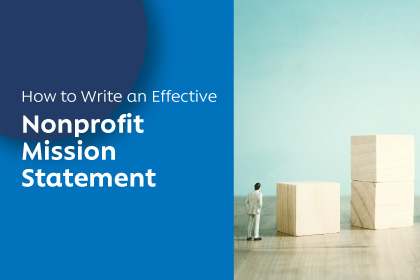
Whether your nonprofit is an enterprise-level organization or a team of one, your mission statement serves as the heart of both your cause and your fundraising strategy. Writing a mission statement that summarizes your nonprofit tends to be easy, but writing one that effectively positions your nonprofit to appeal to donors can be tricky.
Your mission statement informs how you interact with your supporters, from how you ask for donations to which corporations you agree to partner with. Both individual supporters and organizations will read your mission statement before engaging with your nonprofit. This means your mission statement shouldn’t just provide information on your nonprofit but also appeal to readers who are on the fence about offering their support.
To help your nonprofit begin workshopping your mission statement, this article will explore three principles for crafting effective mission statements that will serve your organization long term. These writing principles include:
- Consider Your Organization’s Goals
- Write for Your Audience
- Give Yourself Room to Grow
While you and your team know your nonprofit best, effectively framing your nonprofit’s mission statement to match both your organization’s goals and appeal to your audience may require a few drafts. If you find your nonprofit is hitting a wall, consider seeking out help from a marketing or fundraising consultant who can provide insights on what makes a mission statement successful. That being said, many nonprofits can successfully craft their mission statements themselves, especially when adhering to these tips.
Consider Your Organization’s Goals
Your mission statement should succinctly articulate what your nonprofit aims to accomplish. Nonprofit missions vary in specificity, from organizations founded to solve one or two specific problems to those with broad and evolving objectives. Your approach should encompass both your immediate and long-term goals, so your mission statement can maintain consistency across initiatives.
Be sure to also consider your nonprofit’s values and how those values impact your approach to your mission. Here a few questions to ask that will help you gain a deeper sense of your nonprofit before writing your mission statement:
- Why this cause? Nonprofits strive to make the world a better place in a variety of sectors, from the arts to the environment to societal and social equality. There are also a multitude of ways to approach each of these topics, so why has your nonprofit chosen to combat the problem that you have? Some nonprofits answer this by describing the potential impacts of their efforts, while others note that they are the only organization of their type.
- Why is your nonprofit uniquely qualified to fulfill this mission? With over a million nonprofits operating in the U.S., chances are there is an organization with a similar goal to yours. So why does your nonprofit deserve donations over other causes? It can be difficult to think about your nonprofit competing with other organizations seeking to do good, but the most effective fundraising appeals stem from the ability to clearly state how your nonprofit is different and why that difference matters.
- What does a world where your nonprofit’s mission is fulfilled look like? Envisioning scenarios wherein your nonprofit has completed all of its goals is called futuring. Futuring can be used in a variety of ways, but progressive organizations can use it to better articulate the ultimate purpose behind their actions to outsiders. Some nonprofits feel their mission is inherently important—and it likely is!—but they still need to articulate that importance in writing, which is where futuring comes in handy.
Even if you know where your nonprofit stands on all of these questions, putting your answers together into a few easily consumable sentences can still be a major undertaking. It’s normal to run through multiple drafts, and don’t hesitate to compare potential mission statements by asking your employees and even your leadership what they think of each option.
Write for Your Audience

Mission statements are external documents, which means that they are written with an outside audience in mind. While internal personnel can use your mission statement to help inform the direction of your nonprofit’s initiatives, your primary goal should be to craft a message for donors, volunteers, and other supporters outside of your organization.
Put yourself in your audience’s shoes and consider their objectives when reading your mission statement. While you can’t account for the exact priorities of every reader, there are a few common goals you can assume they approach your mission statement with the intent to fulfill:
- Gather information. Few donors will give to a nonprofit without understanding its cause. Mission statements can often be taken as a summary of your nonprofit in its entirety. Make sure all essential details about what your nonprofit does and why are included so readers can quickly answer fundamental questions about your organization.
- Determine if donating is worthwhile. Supporters donate for all kinds of reasons. Some gather quantifiable data before coming to a decision, others are moved by emotional stories, and some, such as major donors, are looking for a cause to invest in and a community they can devote themselves to. Accounting for all of these motivations is tricky, but, regardless, your mission statement should make a case for why donating is more than worth the cost.
- Compare your nonprofit to similar organizations. As mentioned, your mission statement helps differentiate your nonprofit from others, and supporters who are interested in contributing to a cause in a specific field are likely to explore their options before making a decision. Using your mission statement as an opportunity to describe what makes your nonprofit different might also help your nonprofit in the long run when seeking other types of funding such as grants.
In addition to these goals, consider how your mission statement will come across to different audiences. For example, as Double the Donation’s guide to corporate philanthropy explains, corporate sponsors want to align themselves with nonprofits whose missions reflect their own philanthropic interests.
When seeking corporate sponsorships, you can reframe your mission statement to more closely match your potential sponsor’s, but you shouldn’t obscure or lie about fundamental aspects of your nonprofit.
For instance, let’s say your organization’s mission is to help low-income families with access to items such as children’s clothing and toys. You could easily reframe your mission slightly to appeal to a corporate sponsor interested in helping children’s education. On the other hand, you’d likely have to stretch your message to its breaking point to appeal to a business dedicated to the environment.
This is also true for foundations and grantmakers. Guides like this one get into the nitty-gritty of writing a grant application, but for the most part, the same principles apply. Your mission statement is part of a story you are telling donors, sponsors, and grantmakers, but that story needs to logically fit with the work your nonprofit is actually doing.
Give Yourself Room to Grow
Your mission statement defines what your nonprofit does, but it shouldn’t limit what it can do. Many organizations change their mission statement as they grow and refine their goals.
For nonprofits, you might find your mission statement shifting as you gain more experience, collect resources, and expand your initiatives. As you gain experience writing case statements for funding opportunities with both corporate sponsors and foundations, you might also decide it’s time to refer back to your original mission statement and see how it can be improved.
In many ways, your mission statement can be considered a marketing document for your nonprofit as it explains to supporters why they should give to your nonprofit. GivingMail’s guide to marketing for nonprofit organizations sums up this tension between effective marketing and staying true to your organization’s original charitable goals: “The mission that each nonprofit serves is the most important thing at the end of the day. Marketing shouldn’t take away from your cause, but should make it easier for you to accomplish what you do.”
In other words, your mission statement shouldn’t restrict your nonprofit’s ability to fulfill additional important goals for the sake of sticking to your initial purpose. While your mission statement shouldn’t be overly broad, remember to give yourself the room to grow. Don’t be afraid to come back to edit or refine your initial mission statement if your nonprofit begins to drift away from it.
The Bottom Line
Your mission statement should encapsulate every part of your nonprofit and appeal to supporters considering whether or not to donate. Effective mission statements are informative and persuasive, and it can take your nonprofit a few tries to find an exact fit. Take your time to draft potential mission statements, and remember you can always edit your mission statement later to reflect your organization’s changing priorities and evolution.
About the Author
Grant Cobb is a fundraising specialist with over 6 years of experience in the nonprofit space. Currently the head of marketing and analytics at GivingMail, he is a huge proponent of data-driven decision-making and the push to bring high-level analytics and fundraising to all.






Entrepreneurs must have an effective mission statement for their venture. I write about entrepreneurism: the good, the bad & everything else. There’s no need to be fancy here. Just say it simply for the moment.
Totally agree with you! No need to be fancy. A clear message is ALWAYS better than a fancy one!